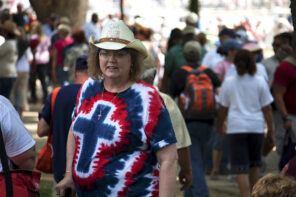Imagine a demographic that has doubled its share of the population over the past two decades, is up by 25 percent over the past four years, and now accounts for as many as one in five Americans. Imagine that this demographic votes disproportionately for one political party—to the tune of 70 percent for Obama versus 26 percent for Romney in the 2012 election. Sounds like a demographic that ought to be of interest to politicians, journalists, and activists, right?
That demographic consists of people who describe themselves as atheist, agnostic, or religiously unaffiliated—the “nones,” as they’re sometimes called. And it hasn’t attracted anywhere near the attention it deserves in the postgame analysis of the 2012 election.
A quick Google search turns up 64,000 results concerning the GOP’s “Latino problem” that became evident in exit poll data on Election Day. Latinos represented around 10 percent of the electorate in 2011, up from nine percent in 2008, and they voted for Obama at a rate of 71 percent. But it’s the nones that should be keeping Karl Rove up at night. Pew put them at 12 percent of the electorate in its exit poll data, and at 19.6 percent in its earlier general survey. (The difference appears to have more to do with polling methodology than with voting habits.)
The Public Religion Research Institute, in a study published on November 15, pegs the religiously unaffiliated at 16 percent of the electorate—and they figure that 78 percent of the category went for Obama. Crucially, like Latinos, the nones are young. One in three Americans under 30 are religiously unaffiliated—four times the rate for the over-65 cohort that keeps Rove in business. This isn’t a trickle, it’s a tsunami.
Google also shows that there’s no shortage of interest in the Republican Party’s “white problem.” The white electorate, long the bread-and-butter of Republican victories, has declined from 81 percent in 2000 to 72 percent in 2012. But if you look under the hood, the Republicans’ white problem is worse than these numbers suggest. For one thing, Romney’s white majority mostly came from racking up huge margins among Southern and rural whites, while Obama actually captured majorities of whites in many blue states and blue urban areas.
The most interesting way to divide whites in America, however, may not be by region, but by religion—or lack thereof. White evangelicals, according to Pew, were as red in 2012 as they’ve ever been. They went 78 percent for Romney, up from 74 percent for McCain. The bad news for the Republicans is that, according to Pew, the evangelical share of the population continues to erode—from 21 percent in 2007 to 19 percent in 2012—while the number of the religiously unaffiliated is rising—from 16 percent to 20 percent over the same period. In other words, “nones” and evangelicals are equivalent in numbers.
One explanation for this change in America’s religious complexion is that white Christians are aging: 72 percent of voters over 65 are white Christians, compared to only 26 percent of voters under 30. Pew also tells us that most of the unaffiliated are white—and that much of their growth has come from the white population. That said, lack of religious affiliation is also common among Asian Americans: while 42 percent of Asian Americans identify as Christian, 26 percent report themselves as religiously unaffiliated, in a significant increase over the general population, and 73 percent of Asian Americans voted for Obama.
Like any group of this size, the religiously unaffiliated aren’t monolithic. About a third self-identify as atheists, while the rest say they are agnostic, “spiritual but not religious,” or simply uninterested in religion. They are spread fairly evenly across education and income levels. And they’re politically diverse when it comes to economic ideas. But they do seem to largely agree on one thing: that mixing religion with politics is a bad idea.
Which brings me back to the recent election. If the statistical data seem unreliable, just think back on the extraordinary nature of the debate in 2012. Never before have the culture wars been fought so forcefully on both sides. While the spectacle of Republicans declaring holy war has become old hat, this was the first election in which one of the parties explicitly endorsed same-sex marriage; this was the first election in which one party defended a woman’s right to reproductive freedom without apology or hesitation; and this season also saw the passage of a number of same-sex marriage ballot initiatives, as well as the election of the nation’s first openly lesbian senator.
Some on the right could scarcely believe that this is what America really wants. “Millions of Americans looked evil in the eye and adopted it,” wrote Liberty Counsel’s Mat Staver in his post-election commentary. He has a point—except that, for the majority of Americans, the “evil” they looked in the eye was the one they rejected on November 6. Others on the right, like the Rev. Dr. Albert Mohler Jr., president of the Southern Baptist Theological Seminary, did get it: “It’s not that our message—we think abortion is wrong, we think same-sex marriage is wrong—didn’t get out. It did get out… It’s that the entire moral landscape has changed. An increasingly secularized America understands our positions, and has rejected them.”
So why haven’t the “nones” gotten the political respect they deserve? Part of the answer is that discrimination against nonbelievers—a large portion of the unaffiliated—remains an acceptable form of bigotry. More than half of Americans continue to say that they would never vote for an atheist for president—many more than will cop to being unwilling to vote for a black or gay person. Politicians are reluctant to associate themselves with such a seemingly toxic group.
The other part of the problem has more to do with a failure of the imagination on both sides of the religious divide. “Nones” (as that unfortunate label suggests) are typically represented by what they are not. They—or at least many of them—do not believe in God, they are charged with lacking “values,” and are suspected of not really being American. But this is nonsense. The unaffiliated do have beliefs, just not necessarily about theistic entities; they have just as many “values” as any other group; and their presence is firmly rooted in American history in helping create the world’s first secular republic.
Although the unaffiliated should not be conflated with atheists, it’s worth concentrating on them as they’re clearly the most feared subcategory. When atheists support same-sex marriage, for example, it’s not because they don’t believe in marriage, it’s because they believe in love and commitment. When they insist on removing creationism from public school curricula, it’s because they believe in the power of science and reason to improve the human condition. And if one should really need proof that atheists are as moral as any other group, they can call in some studies, or look at the growing body of research suggesting that humans’ sense of morality is hardwired and innate.
The politics of the nones in America remains to be written. This diverse group seems united primarily in its members’ opposition to the toxic blurring of religion and government. But if trends continue, perhaps we can look forward to the day when the word “values” is no longer used in political campaigns as a code word for bigotry.




